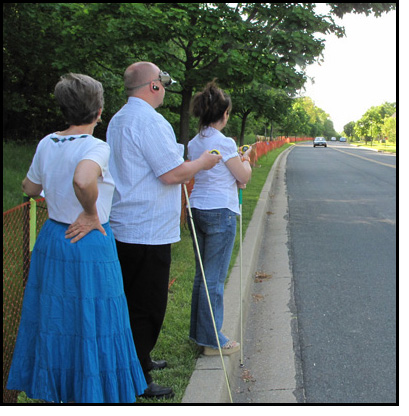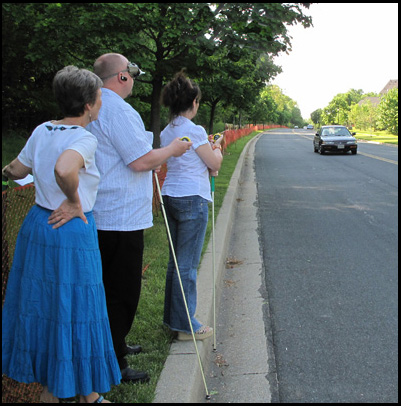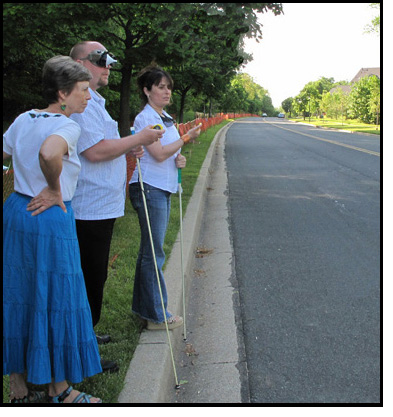Timing Method
for Assessing Speed and Distance of Vehicles (TMASD)
Answers the question:
"Can I determine the speed and distance of approaching vehicles well enough to know
when they are sufficiently far or slow that it's clear enough to cross?"
for Assessing Speed and Distance of Vehicles (TMASD)
Answers the question:
"Can I determine the speed and distance of approaching vehicles well enough to know
when they are sufficiently far or slow that it's clear enough to cross?"
-
For students who can see or hear the vehicles approaching from a distance, this timing method of assessment (TMASD) can be used to teach them how to judge the speed and distance of those vehicles.
The purpose is for them to learn to recognize whether they have enough time to cross even though they know that vehicles are approaching.
Although I have not yet used this with students who rely on hearing, research seems to indicate that people using hearing can judge when the approaching vehicles are far or slow enough to allow time to cross.
 Procedure:
Procedure:
1. Define an arbitrary length of time, which we will call "X" seconds. If the purpose of this procedure is for you to learn to judge when you have a gap long enough to cross, "X" seconds should be the time needed to cross as well as some clearance time and a second to allow for error (see note below). If you simply want to improve your judgment of the speed and distance of traffic, "X" seconds can be any randomly-selected time.
2. Stand at the curb and, as vehicles approach, try to judge (based on their speed and distance) when you think that a given vehicle is X seconds away. Start a stopwatch when you think that the vehicle will reach you in exactly X seconds.
Sometimes, instead of asking students to start the timer when they think the vehicle is "X" seconds away, I ask them to start it when they think they could still start a crossing and reach the other side before the vehicle would reach them -- or try to judge when it's the last possible moment that they could start a crossing without making the drivers have to slow down for them.
 3. Stop the watch when the vehicle reaches you. If the lapsed time is significantly longer or shorter than X seconds, you did not accurately perceive or judge the vehicle's speed, or distance, or both (or you don't have a good understanding of your crossing time -- see "Teaching students to accurately predict crossing time for streets of various width").
Use this feedback to modify when you start the timer the next time.
3. Stop the watch when the vehicle reaches you. If the lapsed time is significantly longer or shorter than X seconds, you did not accurately perceive or judge the vehicle's speed, or distance, or both (or you don't have a good understanding of your crossing time -- see "Teaching students to accurately predict crossing time for streets of various width").
Use this feedback to modify when you start the timer the next time.
4. Continue to judge the vehicles as in steps 2-3, with the goal of improving your judgment until you can discern when the vehicles, regardless of their speed, are approximately X seconds away from you, or when the vehicles are still just far enough to allow you time to cross. As you become skilled, you will start the stopwatch for faster vehicles when they are further from you than you will for slower vehicles. Accuracy can be expected to be within one second of the arbitrary time "X" -- see note below.
CAUTION: If students who are using vision simply start the timer every time the nearest vehicle passes a certain landmark, they will NOT develop and improve their judgment of the speed and distance of those vehicles. Be sure that they are starting the timer when they think that a vehicle approaching at that speed is at a distance such that it will reach them in "X" seconds (or will allow them just enough time to cross).
 NOTE: If a vehicle changes speed while being timed, disregard that trial, since in that situation it isn't possible to know whether you judged its initial speed and distance accurately.
NOTE: If a vehicle changes speed while being timed, disregard that trial, since in that situation it isn't possible to know whether you judged its initial speed and distance accurately.
Doesn't seem to be working?
If your judgment does not improve, perhaps you are unable to perceive the speed and distance of vehicles accurately because of severely restricted visual fields or impaired acuity, or you're unable to cognitively process the speed and distance. In that case, you could consider alternatives for determining when there is enough of a gap in approaching traffic to start crossing.
Alternative for determining crossing gap:
Each of my students who could see the vehicles at a distance but were unable to judge their speed and distance were able to use this alternative easily for determining when the traffic is far enough to allow them to cross.
This alternative for students who are unable to judge the speed and distance of the vehicles is to choose a landmark (such as a driveway, or pole, or tree) at a distance such that even the fastest vehicles take more time to reach them from that spot than they need to cross. The TMAD can be used to help determine if the landmark is far enough -- you can then be confident there is enough time to cross if there are no vehicles closer to you than that landmark.
Note: This is an alternative strategy for those who are not able to judge the speed and distance of the vehicles. While students are still trying to learn to judge the speed and distance of the vehicles, do not suggest that they start the timer whenever the vehicle passes a certain landmark.
Note: People who do not have binocular vision (for example, have only one functioning eye) have done very well with judging the speed and distance of the vehicles. Those who cannot do it are more likely to be people with very small visual fields than people with monocular vision. Perhaps this is because, for judging speed and distance of an approaching vehicle, even more important than binocular vision is the ability to see what is around that vehicle, such as the trees, bushes, and poles that it is passing.
How to determine how many seconds is "X" seconds?
When developing judgment of gaps for crossing, "X seconds" is typically:
- the time needed to cross, plus
- a safety margin ("clearance time"), plus
- an extra second to allow for error.
The one-second error margin is needed because most people can learn to make this judgment accurately within one second or less. That is, they can determine when the vehicle is X seconds away, give or take a second.
The safety margin / clearance time is the time from when you complete the crossing until the first vehicle passes your crosswalk. The preferred clearance time will vary, depending on the situation and the person. People may want more clearance time for fast-moving traffic than they do for slow traffic, and cautious people may want a longer clearance time than do high risk-takers.
The crossing time, preferred clearance time, and error margin should all be considered when determining how many seconds "X" will be. For example, if you need 6 seconds to cross and want a safety margin / clearance time of 3 seconds, you want to be sure the traffic is at least 9 seconds away when you start to cross. Thus your "X" should be 10 seconds, so that if you misjudge a car by one second (a one-second error), you'd still have the full 9-second gap that you want.
Address the issue of scanning:
So far, we have talked about assessing the speed and distance of vehicles by watching the vehicles approaching from one direction at a time. However in real life, people usually need to assess whether there is time to cross by glancing at the traffic approaching from two or more directions. Thus it is important that training with the TMASD be followed up with training or assement with techniques for judging the speed and distance of vehicles by glancing from one direction to another. For issues that must be considered for scanning and glancing with various eye conditions, see "Scanning for Cars."
With these considerations in mind, once the student has learned to judge the speed and distance of the traffic as described above, practice doing it by glancing as follows:
- Have the student face the street.
- Prepare the student by telling him that you will ask him to turn and glance at the approaching traffic and determine whether he would have time to cross.
He should know that for this exercise, he should look at the traffic only long enough to make that determination, then look forward again and report his judgment.
- Once the student is ready, wait until a vehicle or traffic is approaching, then tell the student to turn and look.
As soon as the student finishes glancing at the traffic and starts turning to face forward again, start a stopwatch.
When the vehicle or traffic passes the crosswalk, stop the watch and tell the student how many seconds away it was, and whether it was enough time to allow a crossing (i.e. at least "X" seconds).
- If the student judged incorrectly (for example he thought it was too late to start a crossing but the stopwatch said there was plenty of time), he learns from the feedback and tries to improve the glancing next time (see "Scanning for Cars" for suggestions for improving the glancing).
- Continue until the student has demonstrated accuracy with glancing to assess whether there is time to cross.
Self-Study Guide: what next?
If you're following the Self-Study Guide, you should return to finish reading Teaching at Crossings with No Traffic Signal or Stop Sign (page 2 of the Self-Study Guide).
Return to Teaching at Crossings with No Traffic Signal or Stop Sign
Return to Self-Study Guide: Preparing Visually Impaired Students to Assess and Cross Streets with No Traffic Control
Return to home page